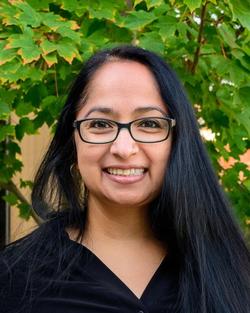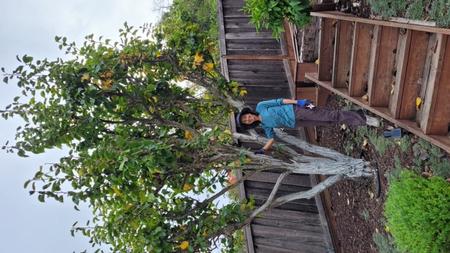The Latest Dirt - Nov 2023
New CoCoMGs Share Their Love for Gardening
By Laura Brainin-Rodriguez

All of this is made possible by our stellar cast of AAMG current and former leads who contribute at Single Day Events and the Great Tomato Plant Sale. In addition, many UC Master Gardeners volunteer regularly at our tables, bringing their expertise and enthusiasm directly to Contra Costa County residents.
One unique subset of our regular volunteers is newly and newer minted UC Master Gardener. We are always thrilled when we get the fresh perspective and contributions of these volunteers. To see them go from not knowing what to expect to confidently using the resources we have as they answer questions from the public is truly special.
We invited some of these newer volunteers to share with you their backgrounds, tell us what attracted them to become a UC Master Gardener, what they have gotten out of being a UC Master Gardener, and if there was anything unexpectedly rewarding.
We will now introduce Sangita Baxi and Chris Tanaka, both 2023 class graduates, and Henry Shaw, who became a Master Gardener in 2022, and let them share in their own words.

His formal academic training is in geology and chemistry. Henry retired in late 2019 from a 35–year career at Lawrence Livermore National Laboratory, the last 10 years as Chief Scientist for Physical and Life Sciences. Before that, he had worked on a diverse collection of projects and issues, including nuclear waste disposal, fission–fusion hybrid power systems, environmental microbiology, and the role of the soil microbiome in carbon sequestration and safe disposition of surplus weapons-grade plutonium.
These days, in his spare time, he volunteers at the Exploratorium, is the current President of the Diablo View Orchid Society, and, with his wife Marina, is an avid forager of edible mushrooms and seaweeds.
Sangita Baxi – I’ve loved growing plants ever since I can remember. Growing up, my brothers and I helped my mom with her garden. I especially remember summers full of roses and hot peppers. As an adult, I bring plants into whatever space I can – growing both ornamentals and foodstuffs in containers on balconies, patios, and even indoor spaces. Outside of plants, I worked as a biologist in a pharmaceutical company for many years and am currently working on my dissertation for a PhD in policy analysis.
Chris Tanaka - I grew up in Hawaii, attended college at the University of Hawaii (UH), and later received a Bachelor of Science in Nursing degree from Creighton University in Nebraska. I practiced nursing in clinical and non-clinical areas before retiring from the County Health System two years ago.
What attracted you to become a UC Master Gardener?
Chris Tanaka - My interest in horticulture began as a child. I loved planting and picking marigolds for my mom. I would harvest and eat “volunteer” tomatoes that grew from under our house. My fascination took off when I chose to enroll in a botany class at UH as an elective. From there, my curiosity grew. I needed to know much more. Career and family commitments took center stage, but the fascination with the plant world never faded. Retirement opened the gate for me to begin the exploration and jump in with two flat feet. Becoming a UC Master Gardener was my ticket!
Henry Shaw - As stated in my bio, I’ve been a gardener since I was a very young child. I think my genetics hardwires it. I had been aware of the UC Master Gardeners for decades. When I retired in 2019, I figured becoming a UC Master Gardener was a natural way to give back to the community by sharing my knowledge and experience with others.
Sangita Baxi - I’ve known about the UC Master Gardener program for many years, but training and work schedules didn’t work out before the last cycle. The mission of evidence–based community education and building relationships with fellow gardeners of all ages drew me in. The hybrid training model allowed me to complete my training while still working.
What have you gotten out of being a Master Gardener so far?

Chris Tanaka - My circle of fellow UC Master Gardener friends grew tremendously! My continuous learning and sharing with them has just begun. It has become even more robust since meeting the folks from previous classes who have lived and experienced the “CoCoMG life” for years before my arrival. We share garden successes, failures, experiences, photos of critters, pests, harvests, laughter, and much more!
I volunteer at the AAMG table at a Farmer’s Market. Working alongside my classmates, as well as experienced UC Master Gardeners, makes this event positive and downright fun! I feel comfortable when my teammates quickly assist with a question I am clueless about (i.e., mite infestation in a beehive). I enjoy the varied questions clients pose and often learn from them! One client complained that her fig tree only produces horrible–tasting, non-edible figs. Beyond the ‘I don’t know’ response, suggestions to submit a photo and an email to the Help Desk was the best answer at the time. I was the resource to another resource! Later the same day, another client asked about grafting a female fig branch onto his male fig tree to produce edible figs! We had an entertaining conversation about wasp pollination inside a fig!
I also volunteer at Our Garden to get some hands-on work experience. There’s a niche for everyone working in the garden, depending on their interest. I made my way through the garden and landed in the orchard! I’ve learned about best practices and even how best practices can evolve to become better, depending on so many variables. I’ve learned why the response to a question with ‘it depends’ is so relevant!
Henry Shaw - I’ve met and worked with many other UC Master Gardeners, and I consider most of them good friends. Becoming a UC Master Gardener has expanded my social network in a gratifying way. Furthermore, I love helping people, and being able to share
my admittedly incomplete knowledge with the public at AAGM tables at Farmers’ Markets and other events has also been gratifying. Finally, I’ve received and implemented many ‘tips’ from my fellow UC Master Gardeners, which I’ve used in my gardens and can now share with the public.

Henry Shaw - The camaraderie (and class loyalty!) of the Contra Costa County UC Master Gardeners!
Sangita Baxi - The thing that took me most by surprise is the amazing CoCoMG community. Everyone has been welcoming and kind, and I have enjoyed chatting and learning.
Chris Tanaka - I would say it is the clients’ responses to sharing knowledge that contradict standard practices. Early in my AAMG table volunteer days, a client asked why her sad–looking 6–pack of plants would not thrive. A quick look underneath showed roots aching to escape their prison! The client’s expression was one of gratitude and relief. Problem solved! It is also fun to explain that pulling up a plant’s roots is unnecessary and leaving them promotes healthier soil. Clients love the ‘chop and drop’ method and appreciate the tip on how to work less in the garden!
Have I been surprised by anything since becoming a Master Gardener? Yes, I’m surprised at the sheer volume of skills, tips, and practical interventions I continuously add to my arsenal. Education certainly did not stop in the classroom. With every volunteer experience, I learn something new to improve my gardening skills and hopefully help clients understand. I’ve found my community, love this journey, and hope to be able to give more than what I receive!
We are truly fortunate to have the contributions and talents of these and many other volunteers. They help seed the work we do at AAMG tables.
